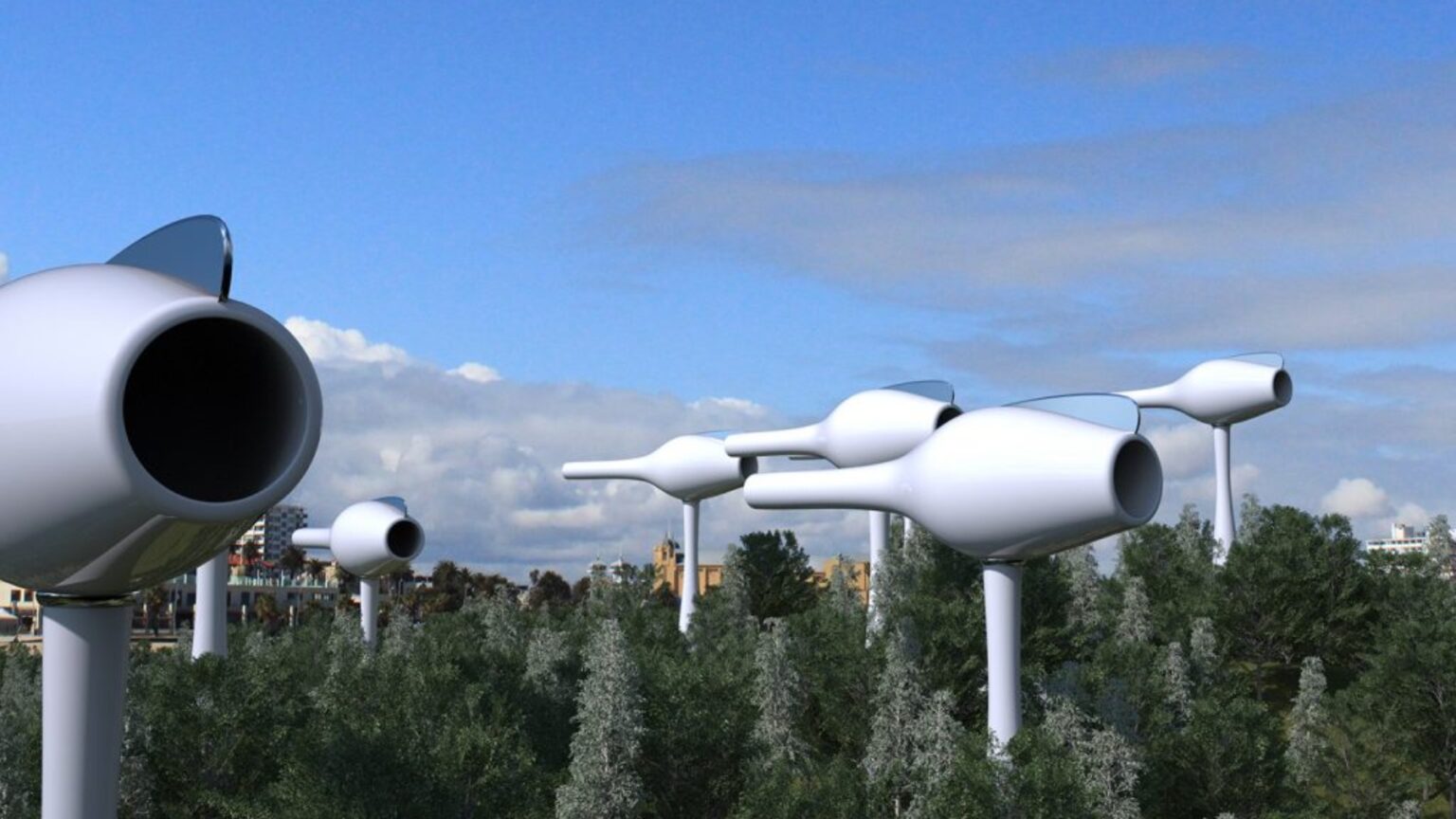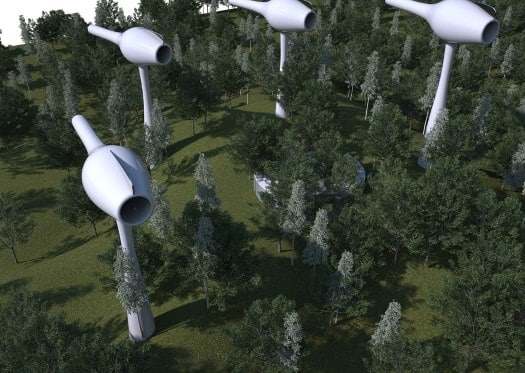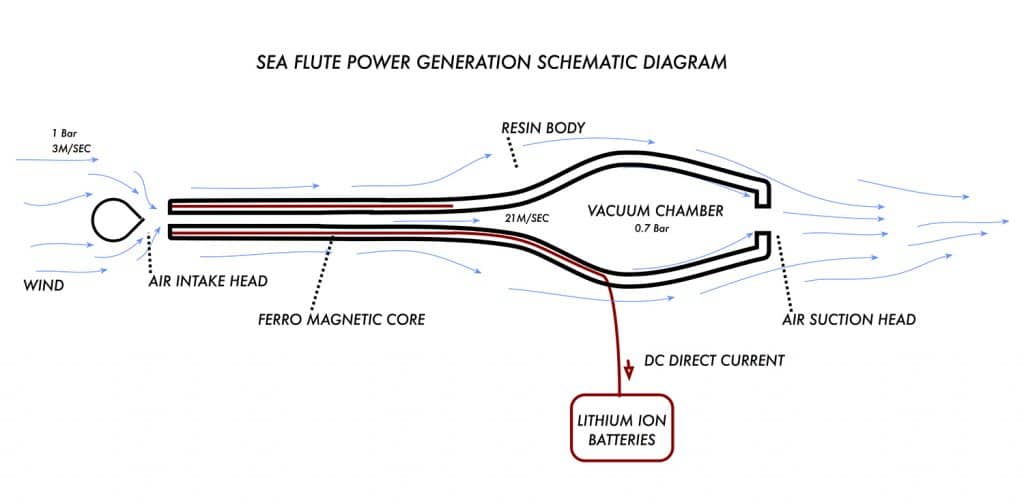Seaflute: The Musical Turbine That Challenges Giant Blades
Seaflute would have solved the problems of wind power: no noise or danger to birds: just music and energy. So what happened to it?

Share
There are inventions that are destined to change the world, and others that seem too good to be true: Seaflute belongs to both categories.
This Canadian wind turbine defies everything we know about wind energy: no spinning blades, no deafening noise, no expensive maintenance. Instead, an elegant design that uses electrostatics and electromagnetism to generate power. The bonus? While it produces clean energy, Seaflute creates programmable melodies that transform any wind farm into a natural symphony. Too good to be true, huh?
The project that made us dream in 2018
Aziz Khalili looked at a traditional wind turbine and thought, “There must be a better way.” His children Iman e Pinprick they agreed. So the Vancouver family did what good engineers do when they're fed up: they threw it all away and started over.
The result submitted to the 2018 Land Art Generator competition for Melbourne, looked like an empty champagne bottle that decided to become an energy machine. It's no coincidence: shape is everything. Seaflute works according to the Bernoulli effect, the same physics that makes airplanes fly. The wind enters the narrow opening and creates a vacuum at the back. Result: a constant flow of air without the need for giant blades cutting into the sky.
The original design was intended for the St Kilda Triangle in Port Phillip, Australia, and on paper it looked perfect. But since then? Silence.

The physics of silence (which remains theoretical)
In the “neck” of the bottle there is an electrostatic ion generator. The air passing through the electric field is transformed into a cloud of charged electrons. These electrons meet the ferromagnetic nucleus and generate direct current by electromagnetic induction.
Translated: no gears, no moving parts, no mechanical noise. Just clean physics that directly converts wind into electricity. According to data from Ionics Research + BETTER, each unit should produce 1.200 MWh annually. Enough for 120 Australian households, assuming anyone actually builds it.
Seaflute: Seven Years Later, Still Only Promises
Here’s where the story gets interesting, but not in the way I was hoping. From 2018 to today, Seaflute has remained stuck to the initial concept. There are no prototypes built, no field tests, or technical updates from the Khalili family. The most recent articles of 2024 and 2025 They still carry the same promises as the original project, often with the same phrase: “the invention is still in the testing phase”.
But there is no sign of any concrete tests. No patents filed, no funding announced, no communications from the company. Ionics Research + BETTER. It's as if the project crystallized in 2018, becoming more of a fascinating idea than a developing technology.
The Pan flute that never plays
Seaflute doesn't just produce electricity: it should also play music. The frequencies generated would be programmable, turning each installation into a giant musical instrument. A bit like if Pan's flute had decided to start making renewable energy.
It’s not just a matter of aesthetics. Traditional turbines kill birds and bats, disturb neighbors with their constant drone, and require constant maintenance because everything moves, wears out, breaks. Seaflute would eliminate these problems simply by having no moving parts. Zero maintenance, zero bird mortality, zero noise pollution. Just sweet tunes and clean electricity.
The conditional is a must, since for now everything remains on paper.

When art remains a concept
As we have seen with other innovative wind technologies, the industry is really looking for alternatives to the ever-growing towers. But there is a fundamental difference between presenting an idea and turning it into reality.
Seaflute is one of those projects that capture the imagination but never make the leap from presentation to prototype. Maybe the development costs are too high, maybe the physics don't work as hoped, maybe there's a lack of funding. The fact is that after seven years, we're still stuck with the 2018 concept.
Seaflute and the problem of beautiful ideas
Imagine wind farms singing in the wind, landscapes dotted with works of art that produce energy. It's not a bad prospect, but it's still a prospect. In the meantime, Wind industry continues to grow with more conventional but functional technologies.
Seaflute remains a beautiful demonstration that engineering can be elegant. And that perhaps the future of clean energy doesn’t have to be ugly to look at. But until something concrete materializes, it remains in the limbo of projects that promised to change the world and have lost their way.
Seven years is a long time, even to develop a truly innovative technology. The silence of Seaflute has become more eloquent than its promised melodies.
Comments
Post a Comment